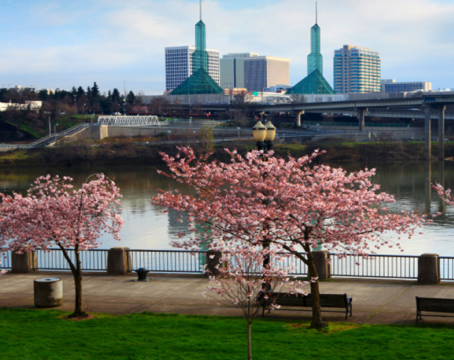Portland Water Bureau Case Study
Challenge
One of the largest cities in the Pacific Northwest, Portland is known for its cool, rainy winters and warm, dry summers with little to no rainfall. In 2010, the Portland Water Bureau initiated a two-year study to see how much water could be saved with new water conservation technologies. Because commercial outdoor irrigation accounts for a lot of water used in Portland, the study focused on irrigation controllers. With the help of landscape consultants, Baseline soil moisture sensors were chosen and tested at seven different locations identified as heavy water users during the summer.
Baseline soil moisture sensors and controllers use Time Domain Transmission (TDT) technology to electronically measure volumetric soil moisture. The durable sensors are buried in the landscape to provide sensitive, repeatable, and accurate readings that automatically adjust irrigation schedules to maintain optimal soil moisture. Like a thermostat, the controller skips scheduled irrigation times if the moisture level is above a certain threshold. Irrigation resumes when the moisture level falls below that level.
Baseline equipment was selected, in part, because it could be easily integrated with existing field wiring, so no new wires were required to install the sensors. The bureau also liked advanced features such as remote monitoring, remote control, and flow monitoring.

Participants achieved 34% water savings overall
Solution
The Portland Water Bureau averaged ten years of water data for all of the participants from 2000-2009. The 2010 and 2011 results with soil moisture sensors installed were compared against those averages. In order to account for consumption variability due to weather conditions, correction factors were applied to normalize the 2010 and 2011 monthly data.
McDonald’s Restaurant – 597,800 gallons, 74.3% savings
This site had a history of high water use and the owner hoped to reduce water costs. The cost-effective Baseline WaterTec S100 unit was installed as an add-on to an existing controller at this small site. McDonald’s saved a significant amount of water after improving the distribution uniformity of its existing sprinkler system and installing the soil moisture sensors. They even saw a marked improvement in turf quality.
Metro Center – 175,000 gallons, 34% savings
As the home of the Portland regional government, the Metro Center provides information and tools to help the community implement sustainable practices. Half of the planter beds on this site used heavy clay soil, with a light-weight soil mix in the other half. The BaseStation 3200 controller was able to effectively monitor moisture conditions for both types of soil. The combination of irrigation improvements and soil moisture sensors resulted in significant savings.
Rose Quarter – 816,900 gallons, 30.8% savings
This site features a very large lawn area on a south-facing slope with sandy soil that is a challenge to keep green in the summer. In 2010, several areas developed dry spots due to sprinkler coverage issues. The landscape contractor addressed these spots by raising the moisture threshold in the BaseStation 3200 controller, which resulted in increased irrigation.
Oregon Museum of Science and Industry (OMSI) – 792,900 gallons, 37.8% savings
OMSI is another showcase in the Portland area for education on water conservation practices. In 2010, a major underground water leak went undetected for the whole season. Therefore, only the data for 2011, after the leak was fixed, is included in the study results. The BaseStation 3200 controller has advanced flow monitoring capabilities that could have detected this leak, but it was not feasible to install wired flow sensors at this site. In the future, it may be possible to use wireless flow sensors for this and similar sites. In 2011, a mainline break occurred and was detected by the BaseStation 3200 controller.
PacWest Center – 341,900 gallons, 17.1% savings
This downtown high-rise building was a late entry to the program with only one year of data. Multiple levels of planting beds on different stories were previously irrigated using four controllers. According to the study report, this complex setup was easily incorporated into a single BaseStation 3200, resulting in water savings of 17.1%.
Baseline Products
BaseStation 3200™
biSensor™ Soil Moisture Sensors
Baseline WaterTec S100 ™
BaseManager™ Central Control
Participants achieved
34% water savings overall
Project Details
McDonald’s Restaurant:
597,800 gallons, 74.3% savings
Metro Center:
175,000 gallons, 34% savings
Rose Quarter:
816,900 gallons, 30.8% savings
Oregon Museum of Science
& Industry (OMSI):
792,900 gallons, 37.8% savings
PacWest Center:
341,900 gallons, 17.1% savings

